Review: Dora Wings 1/48 Seversky P-35A
The P-35 was a military development of the Seversky SEV-3 three- seat amphibian, designed by Alexander Kartveli, Seversky's chief designer and was the first aircraft produced by Alexander P. de Seversky's airplane company. The SEV-3 flew in June 1933 and was developed into the Seversky BT-8 basic trainer, of which 30 were ordered by the Army Air Corps in 1935. It proved manifestly underpowered and was quickly replaced by the North American BT-9.
The second prototype SEV-3 was completed as a two-seat fighter, the SEV-2XP, powered by a 735 hp R-1820 Cyclone with fixed landing gear in aerodynamic spats.When the Air Corps announced a competition for a new single-seat fighter in 1935, Seversky sent the SEV-2XP, expecting it to win despite being a two-seater. However, the aircraft was damaged on 18 June 1935 during its transit to the fly-offs at Wright Field; some people think this was intentional, since Seversky had in the meantime learned about the Curtiss Model 75, which was a single-seater with retractable undercarriage, The competition was delayed while Seversky was allowed to “rebuild” the aircraft into the virtually-new SEV-1XP, a single seater with a retractable undercarriage and a more powerful 850 hp R-1820-G5 replacing the SEV-2XP's engine. The SEV-1XP arrived at Wright Field on August 15 for a successful evaluation, though the Cyclone failed to deliver its rated power and the SEV-1XP only reached 289 mph, not the 300 mph advertised by Seversky.
Protests from Curtiss delayed the formal flyoff between the two competitors until April 1936, with both Seversky and Curtiss taking the opportunity to improve their aircraft; in the meantime Vought entered the V-141 while Consolidated came up with a single seat version of the PB-2. The SEV-1XP now had a Pratt & Whitney R-1830-9 "Twin Wasp" and a modified vertical stabilizer and was designated SEV-7.
The new engine also failed to deliver its rated power only reaching 738 hp and top speed was again well below 300 mph. While the SEV-7 was more expensive than either Curtiss' or Vought's entries it won the competition and received an order for 77 P-35 fighters and spare parts equal to eight airplanes on June 16, 1936 at a cost of $1,636,250.
The first production P-35 was delivered in May 1937, and delivery of 76 was completed in August 1938. Unhappy with Seversky's slow delivery of the P-35 and sale of 2PA two-seat fighters to the Japanese Navy, the Air Corps ordered 210 Curtiss P-36s that summer.
Seversky continued to develop the design with the hope of selling more to the Air Corps and export customers. The SEV-1XP was turned into a single seat racer, the S-1, which took 4th place in the 1937 Bendix Trophy race, in which the S-2, a similar aircraft built for Frank Fuller took first place. The S-2 also won the Bendix in 1939, placed second in 1938, and portrayed the "Drake Bullet" in the 1938 film “Test Pilot.”
Aiming to increase sales, Seversky flew a demonstrator on a tour of Europe in early 1939, resulting in the sale of 15 EP-106 fighters to Sweden on June 29, 1939. This was a development of the P-35 powered by a 1,050 hp R-1830-45, which increased speed by over 25 mph and armed with two 7.9 mm machine guns in the cowl and two 13.2 mm machine guns in the wings. A second order for 45 was placed on October 11, 1939, with a third order for 60 aircraft on January 6, 1940. Known in the RSAF as the J-9, the EP-106 was operated by Wing F 8, protecting Stockholm. They served in Flygvapnet as a fighter until 1946, after which 10 were equipped with cameras as photo-recon aircraft. The last seven J-9s remained in service until September 1952.
On June 18, 1940, United States declared an embargo against exporting weapons to any nation other than the United Kingdom. Now named Republic, the company continued production of the final 60 EP-106s, which were taken over by the Air Corps on October 24, 1940, as the P-35A. They were rearmed with a pair of .30 caliber guns in the nose and a .50 caliber gun in each wing. Flight instruments were metric, and both the labeling and flight manuals were in Swedish. Three remained in the U.S. as instructional airframes and six were delivered to Ecuador to form the Ecuadorian Air Force's Escuadrilla de Caza.
The remaining 51 were sent to the Far East Air Force in the Philippines beginning in February 1941, arriving still marked with Swedish insignia and with Swedish erection manuals. The three pursuit squadrons on Luzon transitioned to the P-35A from the P-26 that spring, losing 10 in accidents. No one had any opportunity to fire their weapons because of a critical shortage of .50-caliber ammunition, though they were flown often to give the pilots experience in a modern airplane since P-40s were expected that summer, which put a strain on the engines since no replacements were available. Following the arrival of P-40Bs in July and P-40Es in September and October, the P-35s were earmarked for transfer to the Philippine Army Air Corps.
In November 1941, after the 3rd Pursuit Squadron re-equipped with P-40Bs and the 17th Pursuit Squadron received P-40Es, most of the P-35As were passed to two newly arrived squadrons, the 21st and 34th Pursuit Squadrons. In late November the 21st received P-40Es on the eve of war and the P-35As went to the 34th Pursuit Squadron, at Del Carmen Airfield. When war came a few weeks later, they were hopelessly outclassed by lack of armor and self-sealing fuel tanks. Twelve were destroyed and six damaged by a Japanese strafing attack on December 10 and by December 12, only eight were still in flying condition.
On December 10, 1st Lieutenant Samuel H. Marrett led six P-35As of the 34th Pursuit Squadron to attack Japanese ships participating in the invasion at Lingayen Gulf. The other five were shot down by defending Japanese fighters. Marrett is credited with sinking of the minesweeper W-10 after making multiple strafing runs until the ship blew up as he passed over, tearing off a wing and causing his fatal crash in the gulf.
On December 17, 2nd Lieutenant Lamar Gillet of the 17th Pursuit Squadron was sent to Del Carmen to collect a P-40, which in the event had been destroyed in an enemy attack earlier. Word was received of Japanese landings in Limon Bay and volunteers were sought to make an attack with the remaining P-35s. Gillet had considerable time in the airplane and was one of four to volunteer. As it worked out, only his airplane and that of 1st Lt. Samuel Anderson started successfully.
Anderson, mistaking Gillet for the Captain who was supposed to lead the mission, formated on Gillet's wing. They arrived over Limon Bay and found a full-scale invasion. They made one strafing pass, during which Anderson was hit and pulled away. As Gillet climbed toward the clouds to escape the enemy fire, an A6M2 Zero of the Tainan Air Corps dropped out of the clouds above to see what the commotion was below, right in front of Gillet. “I opened fire with all my guns and probably killed him soon after , but I was too green and I followed him all the way down till I ran out of ammo.” Gillet managed to get back to Clark airfield, where the anti-aircraft gunners of the New Mexico National Guard nearly shot him down. He had just scored the P-35's only aerial victory, but it was mistakenly credited to Anderson. In 1986, the AFAA recognized Gillet's claim, though the usual “cut and paste” aerial hysterical books still credit Anderson as late as 2003. (I met Lamar at Planes of Fame in 1997 and did an article about him that appeared in Flight Journal in 2001, and his full story is told in my book “I Will Run Wild”)
In January 1942, the five surviving P-35As attempted to fly to Bataan from Lubao Airfield, Two - including the one flown by Gillet - were shot at as they attempted to land, with Lamar successfully landing while the other crashed. With no way to repair the airplane at the time, Gillet became an infantryman and was among those who surrendered on Bataan on April 4, 1942. He survived the Bataan Death March and three years as a “guest of the Emperor” in Japan.
After the war, Gillet found that his airplane had been repaired and that 1st Lieutenants Thomas J.J. Christian and Joe Kruzel of the 17th squadron flew it to Mindanao where they caught a B-17 ride to Australia, where Kruzel became a flight leader in the 49ers when the 49th Fighter Group arrived, training John D. Landers and George Preddy, while Christian became commander of the 67th Fighter Squadron at Guadalcanal. Both later reunited in States and took the 361st Fighter Group to the UK in early 1944. The P-35A was lost in a crash-landing on Cebu on April 10. The surviving P-35A was turned over to Capt. Ramon Zosa of the PAAC on April 30; he flew its last mission from Del Monte Airfield, accompanying a P-40 on a strafing attack of Japanese landings at Macajalar Bay on May 3, 1942.
The Kit:
Hobbycfraft made a P-35, P-35A and Seversky racer in the early 1990s, which were until the release of this kit by Dora Wings the only 1/48 plastic kits of the Seversky fighters available. The kits were not Hobbycraft's best, and this kit, which is thoroughly accurate and very well-detailed, turns them into the doorstops they have aspired to be for 30 years. Other P-35 and P-35A kits have been released in 1/72 by Special Hobby in various releases - including one which claims to be the airplane Lamar Gillet shot down the Zero with. Special Hobby's 1/72 kits are accurate, though they are not easy, being limited-run releases.
This first kit from Dora Wings is released as a Flygvapnet J-9 in World War II neutrality patrol camouflage and markings with oversize insignia. Eugen tells me there will be a later release of a USAAC P-35A in Philippines markings, as well as an original P-35, as well as an S-2 racer.
Since I had the Wolfpack Designs re-release of the Hobbycraft kit, with nice resin updates, photo-etch cockpit detail and decals for P-35As in the Philippines, I decided to jump the gun and go for a Philippines P-35A.
Construction:
Like the MB 152, this is a “high-end/limited-run kit.” Pay attention to the latter and you will achieve the former.
I used the Wolfpack details such as the photoetch seat and the seatbelts and the instrument panels to improve the very nice cockpit Dora Wings has here. The instructions are very good and I had no trouble in assembly by committing the radical act of actually paying attention to the instructions.
With care in cleaning up parts, the model assembles nicely if you take your time and test fit test fit test fit. I had to trim the elevators so they would fit to the horizontal stabilizer so I could droop them, sanding off just a bit of the inner edge to get things to open up enough to move them. The engine took some fiddling and I ended up using Evergreen rod for details since the parts are really fragile and getting some of them off the sprue is close to impossible.
Be sure to put that baggage compartment door in place before attaching the fuselage halves together, because you have to trim it to fit and you want to be able to work it from both sides to get it right.I didn't do that, with the result that it's the worst-looking part of the assembly, so learn from my mistake. As it was, since I had to sand down the edges of the door to fit, I scraped the edge of the opening to angle outward, while scraping the edge of the door inward, so it wouldn't accidentally get popped inside when I was attaching it. Thus I speak from experience when I say that if you are doing this kit, attach the door before further assembling the fuselage.
The wing and fuselage sub-assemblies fit nicely. I rubber banded the wing around the tips to bring it in tight against the upper fuselage joint. When it set, all was in proper position and I didn't have to use any filler. With care in assembly, I didn't have to use filler anywhere other than to fill the gap around the windscreen where it attaches to the fuselage.
Colors and Markings:
I gave the model an overall coat of Tamiya X-18 Semi-glass Black, thinned 50-50, for a primer coat then airbrushed Vallejo Aluminum overall. I painted the fabric control surfaces with Vallejo White Aluminum.
I had intended to paint the model as it would have appeared when Lamar shot down that Zero. According to him, the airplanes were painted in late October with Olive Drab over all markings on the upper surfaces, painting around the insignia. No primer was used, and the airplanes were left unpainted aluminum on their lower surfaces. “Once they flew through a Philippines rain storm, the rain wrecked the paint and they looked like they'd already been through a war,” as he described it to me. All those models with the airplanes nicely painted in OD uppers and Neutral Gray lowers are wrong wrong wrong. You now have the testimony of a guy who was there.
However, the model looked so nice in aluminum, I decided to do it as it would have appeared in 1941 before the painting in October.
The Wolfpack Designs decals went on without problem. I did the markings for aircraft #20, assigned to a flight leader in the 17th Pursuit Squadron.
I unmasked the canopy, attached the landing gear and prop. The canopy took some trimming to get it to fit closed. It can be displayed open or closed and I didn't glue it for that reason.
Conclusions:
Dora Wings has delivered an excellent kit of this important but little-remembered fighter, the first Air Corps fighter that was all metal with retractable gear and enclosed canopy. The airplanes weren't much good when push came to shove, but the forces in the Philippines held out for 16 weeks when the Japanese expected to finish up in four, and that resistance upset their schedule enough that a defense could be organized in Australia.
Recommended for modelers with experience with limited run kits.
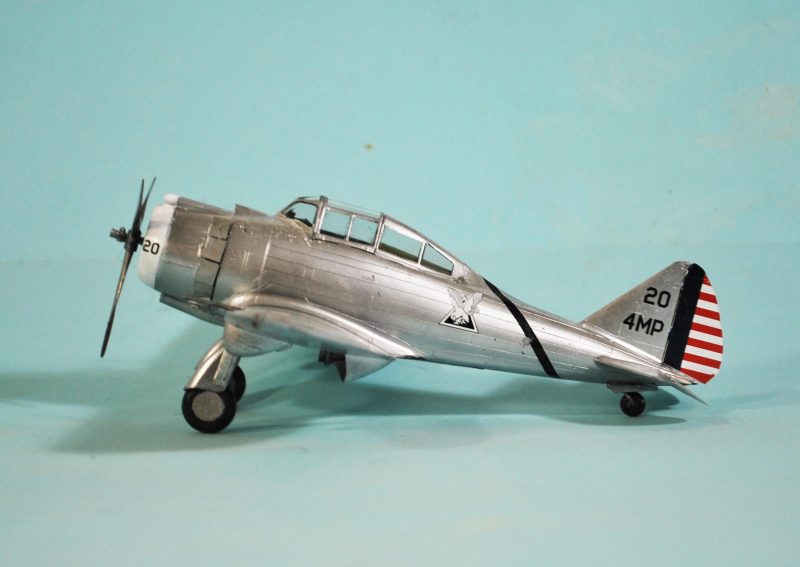
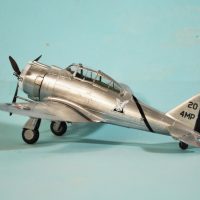
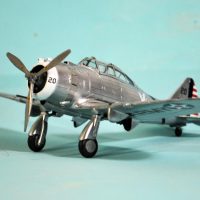
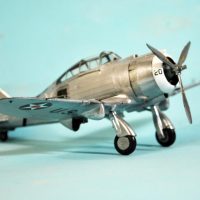
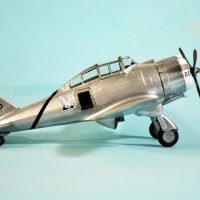
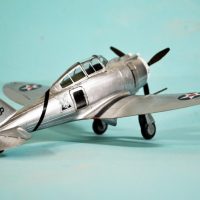
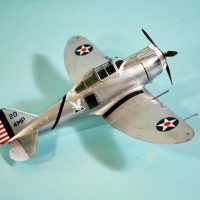
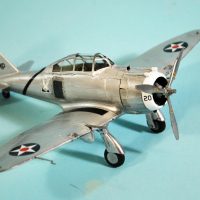
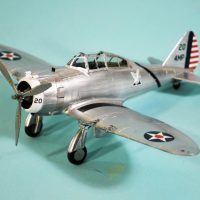

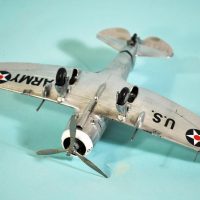

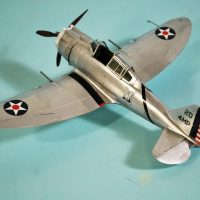
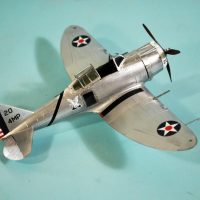
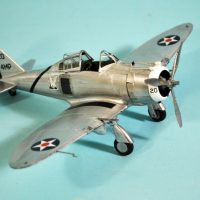
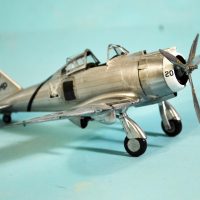

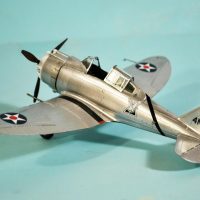
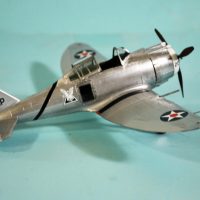
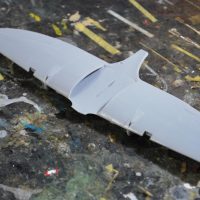
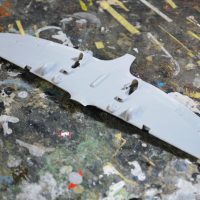

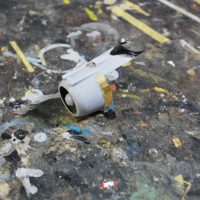
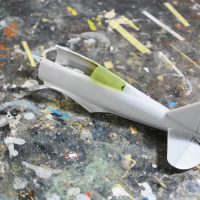

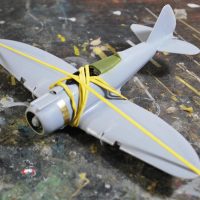
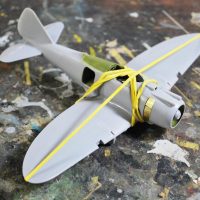


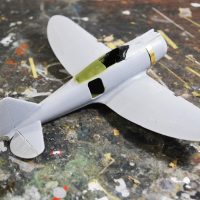
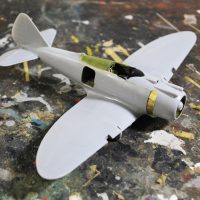
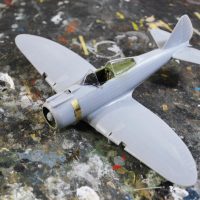
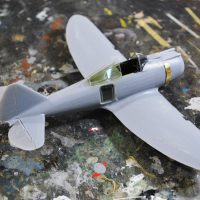
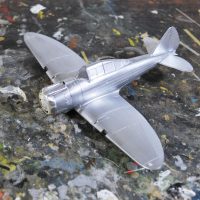
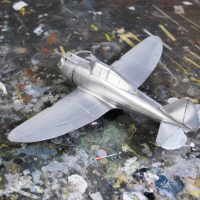
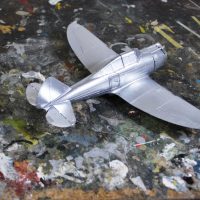
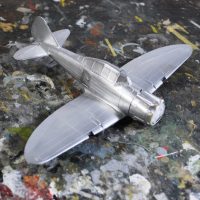
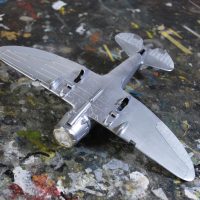
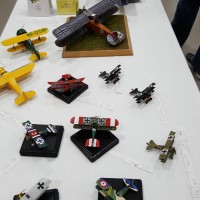

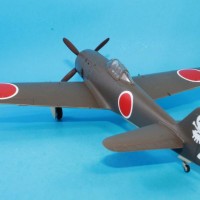
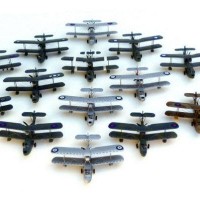
It's a beautiful result, Tom @tcinla
The overal aluminum look is very realistic.
Noticed your article on MM too.
Superb build and equally superb article, @tcinla!
Nice looking build Tom. Shiny works really well.
Natural metal finish is always good looking! What paint did you use?
Vallejo acrylic metallics
Fine result, Tom. I just realized we modeled the same plane pre and post camouflage. Mine was the Wolfpack release.
This looks good in NMF Tom. I'm doing the Swedish version now. Those photo etched cowl gills are a lot of fun to work with aren't they? I really hope DW rethinks this for any future radial engine release. They also didn't supply in the kit the head rest/ armor plate the Swedish versions had and made no note in the instructions Swedish J9's only had the port wing landing light. The wing walk decals are also the wrong shape for the J9
They're probably thinking commercially: the J-9 would land on the lower end of any list of markings possibilities for the kit, so to maximize sales, a company will release the less-popular options first, leading to the most popular, since if the most popular was the first released, many modelers wouldn't get the less popular. You're probably a prime example of who they're marketing to: you have the knowledge and abilities to modify the kit, and you're also very likely to buy the kit again when it comes out in US markings. Thus, they've sold two kit where likely the would have only sold one if marketed the other way.
I agree with the marketing but they should provide the parts and information necessary to complete the version specified on the box.
Perhaps. However, the cost of two different wings is a bit much for a limited-run company operating in Ukraine that is maybe 20 people tops. That it's as accurate as it is, is very fortunate, when one considers the alternative. I doubt it took you over 10 minutes to do the necessary correction. "Some modeling skill required" is still a basic entry point to this hobby. 🙂
Why would they need to do two different wings? All they needed to do is add the headrest and armor plate, very little cost, and note on the instructions to fill in the starboard landing light. This would give the modeler a more accurate J9. A little more research by DW would have solved this. And as I said before, they would make this kit much more buildable if they omit the photo etch cowl gills.
Yeah, the photoetch cowling gills are bad news. I made gills out of thin Evergreen sheet for the P-43.
Great article, Tom. Always an interesting story to go with the build and some good assembly advice.
RSwAF does not use hyphens, it is a J 9, not J-9. Just bit of nit picking but good to know ?
Thanks for the information, Stellan.
TC, one of you better efforts at representing natural metal. Some silver paints the pigment is too grainy. This finish looks like sheet metal. Stating the obvious but, not all metallizers and paints are created equal.
I've been following Kermit Weeks blog or youtube channel on their work on a former Swedish P-35. Prior to reskinning the wings with a mirror finish the original aluminum skins look very similar to your model.
Great job. Really glad to see some of the subjects that DW is tackling. Have a couple of the hobbycraft kits in the stash but the overall look of the nose & wings looks better with the DW.
Very nice. I would love to see this post-rain storm camo! It does stand out in the NMF though.
Dear Tom, this is not just a model building, but a complete research, excellent text and photography. It will be a great help when I will go to build my model in 1/72 scale.
Congratulations for the excellent work.